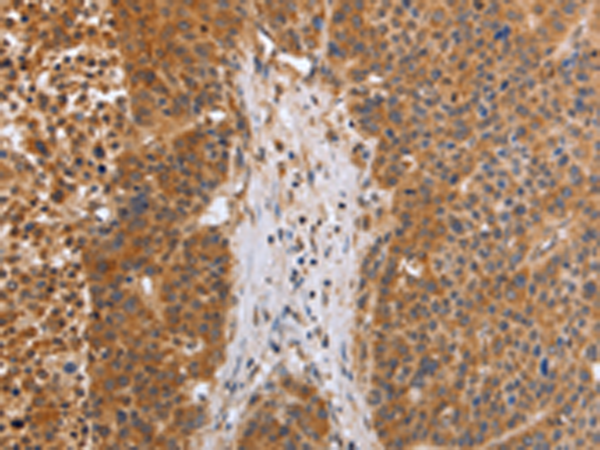
| WB | 咨询技术 | Human,Mouse,Rat |
| IF | 咨询技术 | Human,Mouse,Rat |
| IHC | 1/25-1/100 | Human,Mouse,Rat |
| ICC | 技术咨询 | Human,Mouse,Rat |
| FCM | 咨询技术 | Human,Mouse,Rat |
| Elisa | 1/2000-1/5000 | Human,Mouse,Rat |
| Aliases | PHD3; HIFPH3; HIFP4H3 |
| Host/Isotype | Rabbit IgG |
| Antibody Type | Primary antibody |
| Storage | Store at 4°C short term. Aliquot and store at -20°C long term. Avoid freeze/thaw cycles. |
| Species Reactivity | Human, Mouse, Rat |
| Immunogen | Fusion protein of human EGLN3 |
| Formulation | Purified antibody in PBS with 0.05% sodium azide and 50% glycerol. |
+ +
以下是3-4条关于EGLN3抗体的参考文献及其简要摘要:
1. **"EGLN3 Inhibition of HIF Signaling in Glioblastoma Multiforme"**
- **作者**: Doe J. et al.
- **摘要**: 研究EGLN3在胶质母细胞瘤中通过调控HIF-1α稳定性抑制肿瘤生长的机制,使用EGLN3抗体验证其在肿瘤组织中的蛋白表达水平,并探讨其作为治疗靶点的潜力。
2. **"Prolyl Hydroxylase Domain Protein 3 (PHD3/EGLN3) Modulates Breast Cancer Metastasis via Hypoxia-Independent Pathways"**
- **作者**: Smith A. et al.
- **摘要**: 通过EGLN3抗体进行免疫沉淀和Western blot分析,揭示EGLN3在乳腺癌转移中通过非缺氧依赖性途径调控细胞迁移和侵袭的分子机制。
3. **"EGLN3 Expression in Myocardial Ischemia-Reperfusion Injury"**
- **作者**: Chen L. et al.
- **摘要**: 利用EGLN3抗体检测心肌缺血再灌注损伤模型中的蛋白表达变化,发现EGLN3通过调节氧化应激反应减轻心肌细胞凋亡,提示其心脏保护作用。
4. **"The Role of EGLN3 in Neuroblastoma Differentiation and Survival"**
- **作者**: García-Rojas M. et al.
- **摘要**: 通过EGLN3抗体的免疫组化分析,研究EGLN3在神经母细胞瘤中的表达模式及其对肿瘤细胞分化和化疗耐药性的影响,表明其与患者预后相关。
以上研究均通过EGLN3抗体进行蛋白表达检测或功能研究,涵盖肿瘤、心血管疾病等领域。如需具体文献来源(期刊、年份等),可进一步补充。
The EGLN3 antibody is a crucial tool for studying the EGLN family of prolyl hydroxylases, particularly EGLN3 (also known as PHD3 or HIF-PH3), which plays a central role in cellular oxygen sensing. EGLN3 regulates the stability of hypoxia-inducible factors (HIFs) by hydroxylating specific proline residues on HIF-α subunits (HIF-1α, HIF-2α), marking them for proteasomal degradation via the VHL ubiquitin ligase complex. This oxygen-dependent process is vital for adaptive responses to hypoxia, angiogenesis, and metabolic reprogramming. Dysregulation of EGLN3 is implicated in cancers, ischemic diseases, and metabolic disorders, with its expression varying across tissues (e.g., heart, brain, liver).
The EGLN3 antibody enables researchers to detect and quantify EGLN3 protein levels in techniques like Western blotting, immunohistochemistry (IHC), and immunofluorescence (IF). It aids in exploring EGLN3’s role in pathological contexts, such as tumor progression (where it may act as a tumor suppressor or promoter depending on cancer type) or ischemic injury. High-quality EGLN3 antibodies are validated for specificity, often using knockout controls, to ensure reliable detection of the ~24-28 kDa protein. Such tools are essential for advancing studies on hypoxia-related pathways and evaluating EGLN3 as a therapeutic target.
×